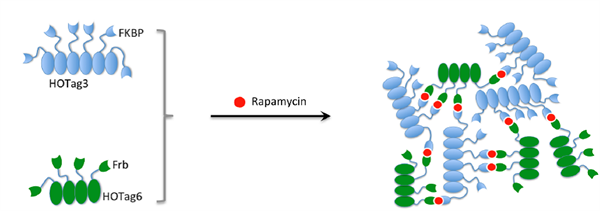“SPARK (Separation of Phases-based Activity Reporter of Kinase)”_A Genetically-encoded Fluorescent Reporter Platform for Studying Cell Signaling in Living Cells
Invention Novelty
This novel class of genetically-encoded fluorescent reporters can be used as powerful tools to study protein-protein interactions (PPIs) in living cells. These bright, reversible reporters have a large dynamic range and fast kinetics, demonstrating significant advantages over traditional FRET-based fluorescent reporters.
Value Proposition
Studying protein-protein interactions in living cells reveals critical information about cell signaling dynamics and cellular mechanisms in both normal and disease conditions. Genetically-encoded fluorescent reporters are ideal for these purposes because they allow non-invasive imaging. However, many PPI reporters, including Fluorescence Resonance Energy Transfer (FRET)-based reporters, have limited dynamic range because of their small fluorescence ratio change of acceptor over donor fluorophores. Transcription-based PPI reporters have poor temporal dynamics, at the timescale of hours, and are not reversible. Therefore, there is a great need for improved fluorescent reporters for imaging of dynamic cell signaling processes and PPIs.
ADVANTAGES OF THE TECHNOLOGY:
- Modular platform enables highly customizable reporter design
- Fast kinetics, large dynamic range (fluorescence change), intense brightness, and simple signal pattern enables quantitative and robust visualization of PPIs
- Rapid and reversible system allows investigation of protein-protein dissociation/inactivation kinetics
- Applicable to live cells so that PPIs are detected in the biological context
Technology Description
The Shu lab at UCSF has developed a novel class of genetically-encoded fluorescent reporters that phase separate upon protein interaction. Dubbed SPARK (Separation of Phases-based Activity Reporter of Kinase), the modular platform can be easily customized to test a large array of interacting proteins. Short peptide Homo-oligomeric Tags (HO-Tags) and a fluorescent protein (e.g. GFP), are genetically fused to proteins of interest, which introduces multivalency. Upon interaction of proteins, the multivalent PPI leads to GFP phase separation, resulting in highly concentrated droplets (reversible upon PPI inhibition), forming bright puncta within the cell.
Looking for Partners
To develop & commercialize the technology as a tool for drug discovery and research.
Stage of Development
Proof of Concept
Data Availability


Related Materials
Patent Status
| Country | Type | Number | Dated | Case |
| United States Of America | Issued Patent | 11,448,654 | 09/20/2022 | 2018-007 |
Contact
- Ragan Robertson
- Ragan.Robertson@ucsf.edu
- tel: View Phone Number.
Inventors
- Shu, Xiaokun
- Zhang, Qiang
Other Information
Keywords
Genetically-encoded reporter, Protein-protein interaction, Cell signaling, Cell assay, Fluorescent reporter, GFP
